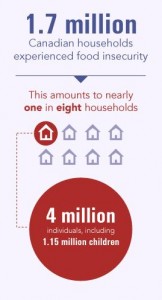 A new report on household food insecurity in Canada shines a light on what continues to be a major social and health problem in this country, and that is the lack of access to sufficient, safe and nutritious food to maintain good health.
A new report on household food insecurity in Canada shines a light on what continues to be a major social and health problem in this country, and that is the lack of access to sufficient, safe and nutritious food to maintain good health. 
The report issued by PROOF – an international, interdisciplinary team of researchers committed to the reduction of household food insecurity – points out that despite regular measuring and monitoring since 2005, food insecurity has remained the same or increased in every province and territory.
In its report, PROOF states that in 2012, four million residents in Canada experienced some level of food insecurity, including nearly 1 in every 6 children. Not only does food insecurity result in physical and emotional hardship, but it also contributes to poor mental and physical health.
In 2012, food insecurity was particularly prevalent in Canada’s North, especially in Nunavut, and in the Maritimes. However, Ontario, Quebec, Alberta and British Columbia accounted for 84% of the food insecure population in Canada due to the population density in these provinces.
Other major findings from the report include:
- Urban residents experience slightly greater food insecurity than rural residents, with rates varying considerably between cities.
- In 2011-12, food insecurity was highest in Halifax, affecting about one in five households. The lowest rates of food insecurity were in Sherbrooke, Quebec City, Hamilton and Greater Sudbury, affecting 1 in 11 householdss
- Being a single mother and having children under the age of 18 was a risk factor for food insecurity.
- More than 16 percent of households with children under the age of 18 reported food insecurity, compared to 11.4 percent of households without children.
- More than 34 percent of female lone-parent households reported food insecurity.
- More than 19 percent of recent immigrants (residence of less than 5 years) reported food insecurity in their households, compared to more than 12 percent of Canadian-born respondents.
- More than 62 percent of food-insecure households obtain their income from employment, attesting to the need for an increase to the minimum wage and improved capacity of government programs, such as the Working Income Tax Benefit, to compensate for low income due to part-time and temporary employment.
- Other populations at risk included individuals receiving social assistance (70 percent were food insecure) and individuals reliant on Employment Insurance or Workers’ Compensation (more than 38.percent were food insecure).
Read more about PROOF and the Report on Household Food Insecurity in Canada, 2012.